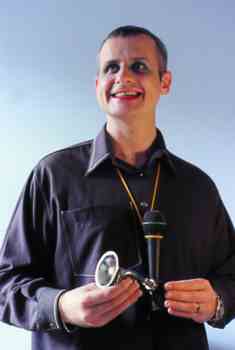Broadcast Quality
Suit-wearing artists working in think-tanks are yesterday’s news. Lisa Haskel reports on TV Swansong
The flyer for TV Swansong is spread across my desk. The silhouette of the British Isles is peppered with icons of transmission towers, the map criss-crossed by vectors between places and complex indices of places, contact information, project descriptions and schedules. Different icons mark remote webcast locations, web access and screening venues, and some quite strange sites where the webcasts are combined with live events that I could visit in person. All this is to help me access to the tangential views and odd imaginings of 11 artists who have been asked to make artworks inspired by television.
 >> Graham Fagen: still from Radio RoselleTV Swansong is an ambitious foray by Nina Pope and Karen Guthrie into creating a temporary artists’ channel for the net. Except it’s not just for the net, because aside from the constant TV-like flow of images and sounds that were scheduled to run in sequence on the TV Swansong website for a mere five hours on Wednesday 20 March, there were a lot of other things happening.
>> Graham Fagen: still from Radio RoselleTV Swansong is an ambitious foray by Nina Pope and Karen Guthrie into creating a temporary artists’ channel for the net. Except it’s not just for the net, because aside from the constant TV-like flow of images and sounds that were scheduled to run in sequence on the TV Swansong website for a mere five hours on Wednesday 20 March, there were a lot of other things happening.
The day contained a performance at a youth centre – part of Zöe Walker and Neil Bromwich’s quest to find some overlap between their real environment and their memories of television; a dance at the Ballroom in Blackpool, organised by Giorgio Sadotti, during which small cameras and microphones hidden in the dancers’ clothes recorded glimpses of the action; the opportunity to visit a working quarry transformed by artists Rory Hamilton and Jon Rogers, using light and sound, into a generic setting for English sci-fi programmes from the 1970s; and an artist (Chris Helson) sent jetting across continents, tagging along with news crews as they follow events to the world’s current affairs hotspots.
The eight artists’ projects commissioned by Pope and Guthrie all took very different approaches. Thankfully these were free from the shallow irony and nostalgia that TV tributes can so easily succumb to.
Graham Fagen chose to pay tribute to illegitimate media with his Radio Roselle during which he performed a weird mish-mash of an imaginary Radio Caroline and the bedroom webcast DJ. The unlikely combination of Robert Burns recordings and early reggae was used to create connections between the colonial histories of Scotland and Jamaica. Meanwhile Jessica Voorsanger created an affectionate exposé of television fakery and constructed celebrity in her show about art made in collaboration with the children’s TV programme SMart.
Pope and Guthrie, in their own contribution Pope and Guthrie’s Recommended Dose, indulged their enthusiasm for hospital dramas. Taking a tangential approach, they decided to find out all about a hospital radio station. Working together with Fay Rusling and Oriane Messina of Smack the Pony fame, they documented their own effort to make a contribution to London’s Whitechapel AM Hospital Radio on Christmas Day. Integrating profiles of the station staff, this piece revealed their characteristic respect for amateurs, hobbyists and volunteers and involved the genuine participation of their subjects.
Jordan Baseman’s The Last Broadcast, based on the 1976 film, Network, is the most intense response to the brief. This piece is a rewrite of the film’s maniacal plea to humanity as a newsreader threatens suicide on screen, and probably the only TV Swansong project in which the unpredictable, halting webcast medium actually adds to the effect.
TV Swansong was a project planned with near-military precision and heavily branded. Somehow this seemed to create an expectation of televisual seamlessness and high production values for the broadcast itself. Unfortunately, however, webcasting infrastructure and images are far from consistent, their quality too chaotic to replicate television and deliver on its expectations. The failure to achieve the unbroken flow and visual quality of a ‘channel’ and the resulting confusion on the part of audiences tended to detract from the artworks.
I couldn’t help wondering if somehow the chosen medium was subtly wrong. It seemed to me that TV Swansong should really have been screened on TV, placing the intervention back into its original habitat and providing an appropriate platform for the video work. If not that, then perhaps only teleportation could have resolved the tension between live presence and mediation that haunted the project. Pope and Guthrie’s work is driven by an infectious passion for people and places, and a set of unmediated encounters might have been my recommended dose.
Lisa Haskel <lisa@southspace.org> works in the field of media arts as an organiser, project manager and researcher
All artists works are available for viewing in the webcast archive [http://www.swansong.tv]
Mute Books Orders
For Mute Books distribution contact Anagram Books
contact@anagrambooks.com
For online purchases visit anagrambooks.com






